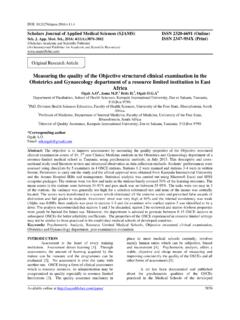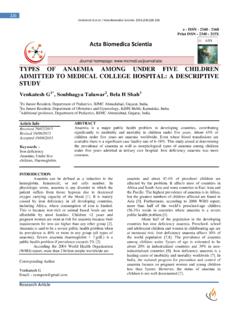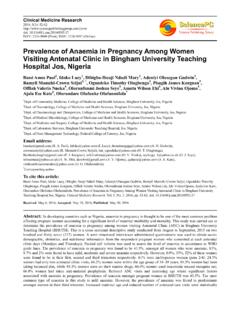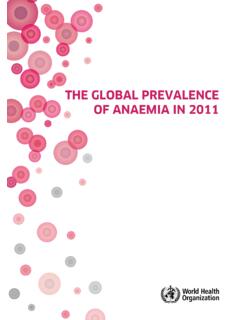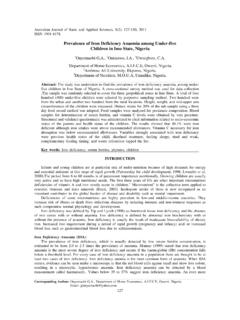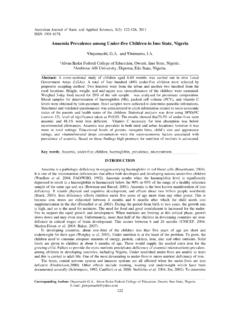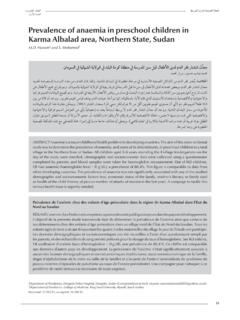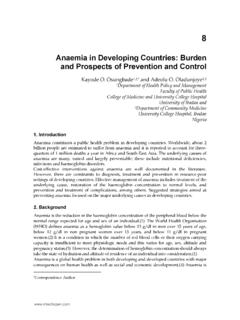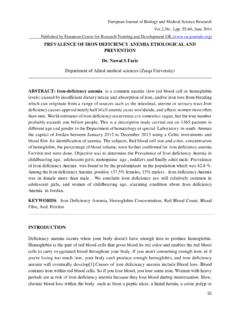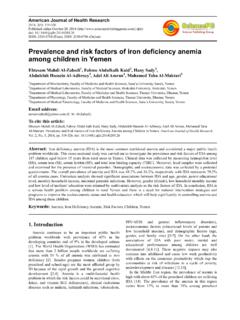Transcription of Research Article Study on Prevalence of Anaemia among ...
1 Scholars Academic Journal of Pharmacy (SAJP) ISSN 2320-4206 (Online). Sch. Acad. J. Pharm., 2014; 3(6): 423-426 ISSN 2347-9531 (Print). Scholars Academic and Scientific Publisher (An International Publisher for Academic and Scientific Resources). Research Article Study on Prevalence of Anaemia among School Children in a Rural Community Setup *Chitra B, Nisha Nair, Jesni K Jose, Jesina Begam, Nazar Ali, Balakrishna College of Pharmacy, Sri Ramakrishna Institute of Paramedical Sciences, Coimbatore, India *Corresponding author Chitra Bhojan Email: Abstract: Anaemia is one of the important public health problem, which affects the world's population widely.
2 among all types of Anaemia , iron deficiency Anaemia is commonly seen in people of developing countries. The Prevalence is high specifically in school children and pregnant women. This Study was designed to evaluate the Prevalence of Anaemia among the school going children in a rural area. A prospective Study was carried out among 700 children of three different schools. The haemoglobin levels were estimated using Sahli's haemometer by acid haemolysis method. The overall Prevalence of Anaemia was which was commonly seen in female children. of the children between the age group of 9 to 11 years were more prone to Anaemia .
3 The haemoglobin levels of 312 children were below 7 g/dl, which indicates that the children were severely anaemic. The severity of Anaemia was analysed and found that around of children were severely anaemic. The below normal BMI levels indicates the nutritionally compromised status of the children. In order to reduce the Prevalence of anemia, the government need to emphasize on community and primary care health programs and create an awareness of healthy diet and reproductive health, which can help to reduce the burden of anemia. Further Research in this area are required to rectify the problem and take appropriate measures to improve the overall quality of life of children, where the pharmacist should play a pivotal role in the health care team by providing patient counselling and health screening Keywords: Anaemia , body mass index, sahli's haemometer, quality of life, nutritional deficiency, iron deficiency anemia.
4 INTRODUCTION adolescence Anaemia is more prevalent in both sexes Anaemia is one of the major public-health especially in girls where they are exposed to risk of problem that affects the world's total population widely onset of menarche. Prevalence of Anaemia is very high [1]. Anaemia is known to affect people belonging to all in vulnerable groups even in higher socioeconomic age-groups, particularly women of child bearing age status. In preschool-age children, the Anaemia and children. World Health Organization (WHO) Prevalence is , affecting 293 million children definitions for Anaemia is as follows: in children's from globally.
5 The highest Prevalence is in Africa ( ). 6 months to 5 year, Anaemia is defined as a Hb level and South-East Asia ( ). In the Eastern <11g/dl, and in children between 5 11 years Hb < Mediterranean, the Prevalence is 46% and around 20%. g/dl [2]. in the other WHO regions like America, Europe and Western Pacific [5]. India has the world's highest Prevalence of iron deficiency Anaemia among women, with 60 to 70 Sant-Rayn Pasricha conducted a Study on percent of the adolescent girls being anaemic [3]. About Determinants of Anaemia among young children in rural two billion people are iron-deficient, with half of them India and found that Poor nutrition and low socio- manifesting clinical signs of Anaemia .
6 It is estimated economic status are the two important primary factors that 75% of Anaemia is related to iron deficiency, to be considered in Anaemia . Strategies for minimizing followed by folate and vitamin B12 deficiencies [4]. childhood Anaemia must include optimized iron intake but should simultaneously address maternal Anaemia , In developing countries it serves as a primary poverty and food insecurity [6]. N. Arlappa et al studied cause for 40% of maternal death either directly or on the Prevalence of Anaemia among rural pre-school indirectly. World Health report of 2002 identified children revealed that 59% of pre-school children living Anaemia as one among the top 10 risks for infant in rural areas were anaemic.
7 Therefore, appropriate mortality, maternal mortality and preterm birth. During intervention measures such as supplementary iron &. 423. Chitra B et al., Sch. Acad. J. Pharm., 2014; 3(6):423-426. folic acid, periodic deworming and health &nutrition the corresponding reading to this level on the scale is education should be strengthened [7]. Baudouin A. recorded in g/dl. The collected data are then screened to Kokore et al studied on the Haematological Status and identify the Prevalence of Anaemia by calculating the Anaemia Prevalence among Children Aged 5 to 11 number of anaemic cases.
8 Years in School Canteens showed that % of children have indicated that at least a parameter of the RESULTS AND DISCUSSIONS. blood count was abnormal owing to the deficiency of The Study results emphasized the high micronutrients. This advises us to avoid the early onset Prevalence of Anaemia among all the age groups of of nutritional deficiency and overload in children that children. The reports of haemoglobin levels in 700. can impede their physical and intellectual capacity[8]. children revealed that were anaemic and Hence, the previous work shows a consistent Prevalence were non-anaemic.
9 (figure no:1).When the of Anaemia with its hold the strongest in children of occurrence pattern of Anaemia was compared to the age growing age. distribution, of anaemic children were between the age group of 6-8 years, between 9-11. The facts show that Anaemia exhibits as one of years, between 12-14 years and of the most prevalent disease and perilous threat to health children were between 15-16 years.(Table No:1).Based care sector, so it becomes a potential subject to be dealt on the above results, the age group of children found with, to increase the quality and life expectancy.
10 Hence highly susceptible to Anaemia were between 9 to 11. this Study was taken up to Study the Prevalence and years. The gender categorization reveals the Prevalence create an awareness about the scenario of the disease of Anaemia was high in females than in males. among state right at the age of childhood and counsel the the 574 anaemic children, were found to be children regarding the importance of iron rich foods in male where as were found to be female order to reduce the Prevalence of the disease. children. (Fig No: 2). Out of the 574 anaemic children, % were found to have haemoglobin below 7 g/dl METHODS AND MATERIALS percentage, % have between 7 10 g/dl and Study site: The Study was conducted in four % between 10-12 g/dl levels.


